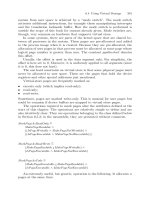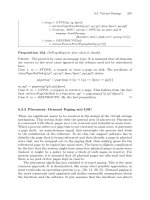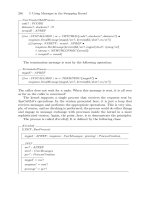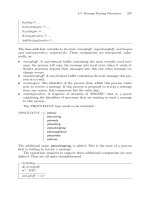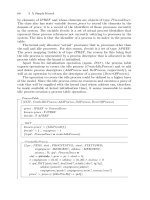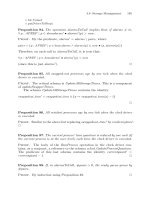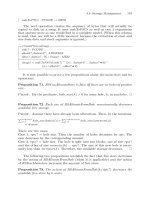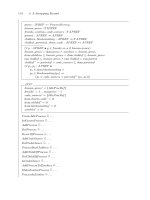Formal Models of Operating System Kernels phần 10 pot
Bạn đang xem bản rút gọn của tài liệu. Xem và tải ngay bản đầy đủ của tài liệu tại đây (266.74 KB, 31 trang )
6.4 Using Virtual Storage 301
system from user space is achieved by a “mode switch”. The mode switch
activates additional instructions, for example those manipulating interrupts
and the translation lookaside buffer. How the mode switch is performed is
outside the scope of this book for reasons already given. Mode switches are,
though, very common on hardware that supports virtual store.
In some systems, there are parts of the kernel space that are shared be-
tween all processes in the system. These pages are pre-allocated and added
to the process image when it is created. Because they are pre-allocated, the
allocation of user pages in that process must be allocated at some page whose
logical page number is greater than zero. The constant pgallocstart denotes
this offset.
Usually, the offset is used in the data segment only. For simplicity, the
offset is here set to 0. Moreover, it is uniformly applied to all segments (since
it is 0, this does not hurt).
The one hard constraint on virtual store is that some physical pages must
never be allocated to user space. These are the pages that hold the device
registers and other special addresses just mentioned.
Virtual-store pages are frequently marked as:
• execute only (which implies read-only);
• read-only;
• read-write.
Sometimes, pages are marked write-only. This is unusual for user pages but
could be common if device buffers are mapped to virtual store pages.
The operations required to mark pages alter the attributes defined at the
start of this chapter. The operations are relatively simple to define and are
also intuitively clear. They are operations belonging to the class defined below
in Section 6.5.2; in the meanwhile, they are presented without comment.
MarkPageAsReadOnly =
MakePageReadable ∧
((IsPageWritable ∧ MakePageNotWritable) ∨
((IsPageExecutable ∧ MakePageNotExecutable)))
MarkPageAsReadWrite
=
(MakePageReadable
o
9
MakePageWritable) ∧
(IsPageExecutable ∧ MakePageNotExecutable)
MarkPageAsCode
=
(MakePageExecutable
o
9
MakePageReadable) ∧
(IsPageExecutable ∧ MakePageNotExecutable)
An extremely useful, but generic, operation is the following. It allocates n
pages at the same time:
302 6 Virtual Storage
AllocateNPages
=
(∀ p :1 numpages? •
(p =1∧ AllocatePageReturningStartVAddress[startaddr?/vaddr!])
∨ (p > 1 ∧
(∃ vaddr : VADDR •
AllocatePageReturningStartVAddress[vaddr/vaddr!])))
As it stands, this operation is not of much use in this model. The reason for
this is that it does not set page attributes, in particular the read-only, execute-
only and the read-write attributes. For this reason the following operations are
defined. The collection starts with the operation for allocating n executable
pages.
The following allocation operation is used when code is marked as exe-
cutable and read-only. This is how Unix and a number of other systems treat
code.
AllocateNExecutablePages =
(∀ p :1 numpages? •
(p =1∧ AllocatePageReturningStartVAddress[startaddr?/vaddr!]
∧ MarkPageAsCode)
∨ (p > 1 ∧
(∃ vaddr : VADDR •
AllocatePageReturningStartVAddress[vaddr/vaddr!] ∧
MarkPageAsCode)))
Similarly, the following operations allocate n pages for the requesting pro-
cess. It should be remembered that the pages might be allocated on the paging
disk and not in main store.
AllocateNReadWritePages =
(∀ p :1 numpages? •
(p =1∧ AllocatePageReturningStartVAddress[startaddr?/vaddr!]
∧ MarkPageAsReadWrite)
∨ (p > 1 ∧
(∃ vaddr : VADDR •
AllocatePageReturningStartVAddress[vaddr/vaddr!] ∧
MarkPageAsReadWrite)))
AllocateNReadOnlyPages
=
(∀ p :1 numpages? •
(p =1∧ AllocatePageReturningStartVAddress[startaddr?/vaddr!]
∧ MarkPageAsReadOnly)
∨ (p > 1 ∧
(∃ vaddr : VADDR •
AllocatePageReturningStartVAddress[vaddr/vaddr!] ∧
MarkPageAsReadOnly)))
6.4 Using Virtual Storage 303
To support the illusion of virtual storage, virtual addresses can be thought
of as just natural numbers (including 0):
VADDR == N
and the virtual store for each process can be considered a potentially infinite
sequence of equal-sized locations:
VirtualStore
vlocs :seqPSU
maxaddr : N
#locs = maxaddr
It must be emphasised that each virtual address space has its own copy of
the VirtualStore schema. Page and segment sharing, of course, make regions
of store belonging to one virtual address space appear (by magic?) as part of
another.
The usual operations (read and write) will be supported. However, when
the relevant address is not present in real store, a page fault occurs and the
OnPageFault driver is invoked with the address to bring the required page
into store.
For much of the remainder, a block-copy operation is required. This is
used to copy data into pages based on addresses. For the time being, it can
be assumed that every address is valid (the hardware should trap this, in any
case).
CopyVStoreBlock
∆VirtualStore
data?:seqPSU
numelts?:N
destaddr?:VADDR
vlocs
=(λ i :1 (destaddr? − 1) • vlocs(i))
data?
(vlocs after (destaddr?+numelts?))
If any of the addresses used in this schema are not in main store, the page-
faulting mechanism will ensure that it is loaded.
Operations defining the user’s view of virtual store are collected into the
following class. It is defined just to collect the operations in one place. (In the
next section, the operations are not so collected—they are just assumed to be
part of a library and are, therefore, defined in Z.)
The class is defined as follows. The definition is somewhat sparse and con-
tains only two operations, CopyVStoreBlock and CopyVStoreFromVStore.In
a full implementation, this class could be extended considerably. The point,
here, though, is merely to indicate that operations similar to those often im-
plemented for real store can be implemented in virtual storage systems at
304 6 Virtual Storage
a level above that at which virtual addresses are manipulated as complex
entities.
UsersVStore
(INIT , CopyVStoreBlock, CopyVStoreFromVStore)
vlocs :seqPSU
maxaddr : N
#locs = maxaddr
INIT
maxaddress?:N
maxaddr
= maxaddress?
CopyVStoreBlock =
CopyVStoreFromVStore =
Data can be copied into a virtual-store page (by a user process) by the
following operation:
CopyVStoreBlock
∆VirtualStore
data?:seqPSU
numelts?:N
destaddr?:VADDR
vlocs
=(λ i :1 (destaddr? − 1) • vlocs(i))
data?
(vlocs after (destaddr?+numelts?))
A similar operation is the following. It copies one piece of virtual store
to another. It is useful when using pages as inter-process messages: the data
comprising the message’s payload can be copied into the destination (which
might be a shared page in the case of a message) from the page in which it
was assembled by this operation:
CopyVStoreFromVStore
∆VirtualStore
fromaddr?:VADDR
toaddr?:VADDR
numunits?:N
1
(∃ endaddr : VADDR | endaddr = fromaddr ?+numunits? − 1 •
vlocs
=(λ i :1 (toaddr ? − 1) • vlocs(i))
(λ j : fromaddr? endaddr • vlocs(j))
(vlocs after endaddr +1))
6.4 Using Virtual Storage 305
6.4.3 Mapping Pages to Disk (and Vice Versa)
Linux contains an operation called memmap in its library. This maps virtual
store to disk store and is rather useful (it could be used to implement persistent
store as well as other things, heaps for instance).
A class is defined to collect the operations together. Again, this class is
intended only as an indication of what is possible. In a real system, it could
be extended considerably; for example, permitting the controlled mapping of
pages between processes, archiving of pages, and so on.
PageMapping
(INIT , MapPageToDisk, MapPageFromDiskExtendingStore)
usrvm : UserVStore
pfr : PageFrames
INIT
uvm?:UserVStore
pgfrm?:PageFrames
usrvm
= uvm?
pfr
= pgfrm?
MapPageToDisk =
MapPageFromDiskExtendingStore
=
writePageToDisk =
readPageFromDisk =
The operations in this class are all fairly obvious, as is their operation.
Commentary is, therefore, omitted.
writePageToDisk
diskparams?:
pg ?:PAGE
MapPageToDisk =
(pgt .PhysicalPageNo[ppno/ppgno!] ∧
pfr.GetPage[ppno/pageno?, pg /fr!] ∧
writePageToDisk[pg /pg ?])
\ {ppno, pg }
306 6 Virtual Storage
readPageFromDisk
diskparams?:
pg !:PAGE
This operation extends the store of the requesting process. It is used when
reading pages from disk. The disk page is added to the process’ virtual storage
image.
MapPageFromDiskExtendingStore =
usrvm.AllocatePageReturningStartVAddress[pageaddr!/vaddr !]
o
9
(readPageFromDisk[pg /pg !] ∧
(∃ sz : N | sz = framesize •
usrvm.CopyVStoreBlock
[sz/numelts?, pg /data?, pageaddr!/destaddr?]))
\{pg }
There ought to be an operation to delete the page from the image. However,
only the most careful programmers will ever use it, so the operation is omitted.
It is, in any case, fairly easy to define.
Note that there is no operation to map a disk page onto an existing virtual-
store page. This is because it will probably be used extremely rarely.
The operations in this class could be extended so that the specified disk as
well as the paging disk get updated when the frame’s counter is incremented.
This would automatically extend the disk image. A justification for this is
that it implements a way of protecting executing processes from hardware
and software failure. It can be used as a form of journalling.
This scheme can also be used on disk files. More generally, it can also
work on arbitrary devices. This could be an interesting mechanism to explore
when considering virtual machines of greater scope (it is an idea suggested by
VME/B). Since this is just speculation, no more will be said on it.
6.4.4 New (User) Process Allocation and Deallocation
This section deals only with user-process allocation and deallocation. The
general principles are the same for system processes but the details might
differ slighty (in particular, the default marking of pages as read-only, etc.).
When a new process is created, the following schema is used. In addition,
the virtual-store-management pages must be set up for the process. This will
be added to the following schema in a compound definition.
6.4 Using Virtual Storage 307
UserStoreMgr
(INIT , MarkPageAsReadOnly, MarkPageAsReadWrite, MarkPageAsCode,
AllocateNPages, AllocateNExecutablePages, AllocateNReadWritePages,
AllocateNReadOnlyPages, CopyVStoreBlock, CopyVStoreFromVStore,
AllocateNewProcessStorage, ReleaseSharedPages,
FinalizeProcessPages, AllocateCloneProcessStorage)
usrvm : UserVStore
pgt : PageTables
INIT
uvm?:UserVStore
ptbl?:PageTables
usrvm
= uvm?
pgt
= ptbl ?
MarkPageAsReadOnly =
MarkPageAsReadWrite
=
MarkPageAsCode =
AllocateNPages =
AllocateNExecutablePages =
AllocateNReadWritePages =
AllocateNReadOnlyPages
=
CopyVStoreBlock =
CopyVStoreFromVStore
=
AllocateNewProcessStorage =
ReleaseSharedPages =
FinalizeProcessPages =
AllocateCloneProcessStorage =
AllocateNewProcessStorage
p?:APREF
codepages?:seqPSU
codesz ?, stacksz ?, datasz?, heapsz?:N
(∃ sg : SEGMENT; codeszunits : N |
sg = code ∧ codeszunits =#codepages? •
308 6 Virtual Storage
AllocateNExecutablePages
[codesz ?/numpages?, addr/startaddr!]
o
9
usrvm.CopyVStoreBlock
[codepages?/data?, codeszunits/numelts?,
addr/destaddr?])
(∃ sg : SEGMENT | sg = data •
AllocateNReadOnlyPages[datasz ?/numpages?])
(∃ sg : SEGMENT | sg = stack •
AllocateNReadWritePages[stacksz ?/numpages?])
(∃ sg : SEGMENT | sg = heap •
AllocateNReadWritePages[heapsz?/numpages?])
ReleaseSharedPages
∆(smap)
p?:APREF
(∀ ps : PAGESPEC | ps ∈ dom smap ∧ pgspecpref (ps)=p? •
(∃ s : PAGESPEC | (ps, s) ∈ smap •
smap
= smap \{(ps, s)}))
∧ (∀ ps : PAGESPEC | ps ∈ ran smap ∧ psgpecpref (ps)=p? •
(∃ s : PAGESPEC | (s, ps) ∈ smap •
smap
= smap \{(s, ps)}))
Once this schema has been executed, the process can release all of its
pages:
FinalizeProcessPages =
pgt .RemovePageProperties ∧ pgt.RemoveProcessFromPageTable
AllocateCloneProcessStorage
p?:APREF
clonedfrom?:APREF
stacksz?, datasz?, heapsz?:N
(∃ sg : SEGMENT | sg = code •
ShareLogicalSegment[clonedfrom?/ownerp?, p?/sharerp?,
sg/ownerseg?, sg/sharerseg?])
(∃ sg : SEGMENT | sg = data •
AllocateNReadOnlyPages[datasz ?/numpages?])
(∃ sg : SEGMENT | sg = stack •
AllocateNReadWritePages[stacksz ?/numpages?])
(∃ sg : SEGMENT | sg = heap •
AllocateNReadWritePages[heapsz?/numpages?])
6.5 Real and Virtual Devices 309
This works because of the following argument. The first of the two
schemata (ReleaseSharedPages) above first removes the process from all of
the pages that it shares but does not own. Then it removes itself from all of
those shared pages that it does own. This leaves it with only those pages that
belong to it and are not shared with any other process.
If a child process performs the first operation, it will remove itself from
all of the pages it shares with its parents; it will also delete all of the pages
it owns. The parent is still in possession of the formerly shared pages, which
might be shared with other processes. As long as the parent is blocked until
all of its children have terminated, it cannot delete a page that at least one of
its children uses. Thus, when all of a process’ children have terminated, the
parent can terminate, too. Termination involves execution of the operations
defined by ReleaseSharedPages and FinalizeProcessPages.
The only problem comes with clones. If the clone terminates before the
original, all is well. Should the original terminate, it will delete pages still
in use by the clone. Therefore, the original must also wait for the clone to
terminate.
An alternative—one that is possible—is for the owner to “give” its shared
pages to the clone. Typically, the clone will only require the code segment and
have an empty code segment of its own. If the code segment can be handed
over to the clone in one operation (or an atomic operation), the original can
terminate without waiting for the clone or clones. Either is possible.
The allocation of child processes is exactly the same as cloning. The dif-
ference is in the treatment of the process: is it marked as a child or as a
completely independent process? Depending upon the details of the process
model, a child process might share code with its parent (as it does in Unix
systems), whereas an independent process will tend to have its own code (or
maybe a copy of its creator’s code). In all cases, the data segment of the new
process, as well as its stack, will be allocated in a newly allocated set of pages.
In this chapter’s model, data and stack will be allocated in newly allocated
segments. The mechanisms for sharing segments of all kinds have been mod-
elled in this chapter, as have those for the allocation of new segments (and
pages). The storage model presented in this chapter can, therefore, support
many different process models.
6.5 Real and Virtual Devices
There is often confusion between real and virtual devices. It is sometimes
thought that the use of virtual store implies the use of virtual devices. This is
not so. In most operating systems with virtual store, the devices remain real,
while in some real-store operating systems, devices are virtual.
Virtual devices are really interfaces to actual, real ones. Virtual devices
can be allocated on the basis of one virtual device to each process. The virtual
device sends messages to and receives them from the device process. Messages
310 6 Virtual Storage
are used to implement requests and replies in the obvious fashion. Messages
to the real device from the virtual devices are just enqueued by the device
process and serviced in some order (say, FIFO).
The interface to the virtual device can also abstract further from the real
device. This is because virtual devices are just pieces of software. For example,
a virtual disk could just define read and write operations, together with return
codes denoting the success of the operation. Underneath this simple interface,
the virtual device can implement more complex interfaces, thus absolving the
higher levels of software from the need to deal with them. This comes at the
cost of inflexibility.
This model can be implemented quite easily using the operations already
defined in this book. Using message passing, it can be quite nicely structured.
There is another sense in which devices can be virtualised. Each device
interface consists of one or more addresses. Physical device interfaces also in-
clude interrupts. Operations performed on these addresses control the device
and exchange data between device and software. The addresses at which the
device interface is located are invariably fixed in the address map. However,
in a virtual system, there is the opportunity to map the pages containing
device interfaces are mapped into the address space of each process. (This
can be done, of course, using the sharing mechanism defined in this chapter.)
This allows processes directly to address devices. However, some form of syn-
chronisation must be included so that the devices are fairly shared between
processes (or virtual address spaces). Such synchronisation would have to be
included within the software interface to each device and this software can be
at as low a level as desired.
A higher-level approach is to map standard addresses (by sharing pages)
into each address space but to include a more easily programmed interface.
Again, the mechanisms defined in this book can be used as the basis for this
scheme.
6.6 Message Passing in Virtual Store
At a number of points in this chapter, the idea of using shared pages (or sets
of shared pages) to pass messages between processes has been raised. The
basic mechanisms for implementing message passing have also been defined.
When one process needs to send a message to another, it will allocate
a page and mark it as shared with the other process. Data will typically be
placed in the page before sharing has been performed. The data copy operation
can be performed by one of the block-copy operations, CopyVStoreBlock or
CopyVStoreFromVStore (Section 6.5.1).
The receiving process must be notified of the existence of the new page
in its address space. This can be achieved as either a synchronous or an
asynchronous event—the storage model is completely neutral with respect to
6.7 Process Creation and Termination; Swapping 311
this. In a system with virtual storage, message passing will be implemented as
system calls, so notification can be handled by kernel operations. For example,
the synchronous message-passing primitives defined in Chapter 5 can easily be
modified to do this. What is required is that the message call point to a page
and not to a small block of storage. Equally, the asynchronous mechanism
outlined in Chapter 3 can be modified in a similar fashion.
Message passing based on shared pages will be somewhat slower at runtime
than a scheme based upon passing pointers to shared storage blocks (buffers),
even when copying buffers between processes is required. The reason for this
is clear from an inspection of the virtual storage mechanisms. For this reason,
it would probably be best to implement two message-passing schemes: one
for kernel and one for user messages. The kernel message scheme would be
based on shared buffers within kernel space; user messages would use the
shared-page mechanism outlined above.
In some cases, additional system processes are required in addition to those
executing inside the kernel address space and they will be allocated their own
virtual store. In order to optimise message passing between these processes
and the kernel, a set of pages can be declared as shared but not incore (i.e.,
not locked into main store). The set of pages can be pre-allocated by the
kernel at initialisation time, so no new pages need to be allocated. All that
remains is for the pages to be given to the processes. This can be achieved
using the primitives defined in this chapter.
6.7 Process Creation and Termination; Swapping
Process creation, activation and termination are unaffected by the virtual
storage mechanisms. The virtual storage subsystem must be booted before
any processes are created, so all processes, even those inside the kernel, are
created in virtual address space. The primitives to allocate and deallocate
storage have been defined above (Sections 6.5.1 and 6.5.3). The operations
to create and delete processes can be implemented in a way analogous to
those defined in Chapter 4 (and assumed in Chapter 5), with the virtual-store
primitives replacing those handling real store. The most significant difference
between the two schemes is that the virtual-store allocation operations are
not as limited in the amount of store they can allocate. The virtual storage
operations are only limited by the number of pages permitted in a segment
and not be the size of main store.
Virtual store also has advantages where swapping is concerned. It is possi-
ble to include a swapping system in a virtual-store-based system. As with the
scheme defined in detail in Chapter 4, the swapper will transfer entire process
images between main store and the swap disk (or swap file). Under virtual
storage, the swapper treats the page as the basic unit for transfer. The swap-
per reads the page table and swaps physical pages to disk. Not all segments
need be swapped to disk; code segments might be retained in main store while
312 6 Virtual Storage
there are active child processes. The process is, however, complicated by the
fact that a process image is likely to be shared between the paging disk and
main store.
7
Final Remarks
Sic transit Gloria Swanson
– Anon.
7.1 Introduction
Rather than just end the book with the virtual storage model, it seems ap-
propriate to add a few concluding remarks.
The chapter is organised as follows. In the next section, the models of this
book are reviewed and some omissions mentioned. In Section 7.3, the whole
idea of engaging in the formal modelling activity is reviewed. Finally, Section
7.4 contains some thoughts about what to do in the future.
7.2 Review
The formal models of three operating systems have been presented. All three
kernels are intended for use on uni-processor systems. They are also examples
of how the classical kernel model described in Chapter 1 can be interpreted;
it should be clear that the invariants stated in Chapter 1 are maintained by
the three kernels.
The first model (Chapter 3) is of a simple kernel of the kind often encoun-
tered in real-time and embedded systems. The system has no kernel interface
and does not include such things as ISRs and device drivers. The user of
this kernel is expected to provide these components on a per-application ba-
sis. This is common for such systems because the devices to which they are
connected are not specified and are expected to vary among applications.
The first kernel can be viewed as a kind of existence proof. It shows that it
is possible to produce a formal model of an operating system kernel. However,
the kernel of Chapter 3 should not be considered a toy, for it can be refined
to real working code.
314 7 Final Remarks
The second kernel is for a general-purpose system. The model includes a
number of device drivers, in particular a clock process that is central to the
process-swapping mechanism. The kernel uses semaphores for synchronisation
and as the basic inter-process communication mechanism (here, shared mem-
ory). The kernel uses a time-based mechanism for multiplexing main store
between processes; the kernel supports more processes than can be simulta-
neously maintained in main store. A storage-management subsystem is also
provided to manage main store. It does so in a fairly rudimentary fashion,
based upon the allocation of relatively large chunks of store for each process
(the actual division of process store is left undefined because it is often deter-
mined by the compiler—GNU C’s approach was at the back of the author’s
mind while producing this model). The chapter contains the proofs of many
kernel properties, and includes a proof of the correctness of the model for
semaphores.
The second kernel is of approximately the complexity of kernels such as
those built by Digital Equipment for the excellent operating systems running
its PDP-11 series of minicomputers in the 1970s. It is of approximately the
complexity of the kernel of Tannenbaum’s Minix [30] system (minus signals,
file system and terminal interface). Indeed, Minix was a significant influence
on the models in Chapters 4 and 5.
The third kernel is not presented in its entirety. It is a variation on the
second one. The two differ in that the third uses message passing for IPC.
The message-passing primitives are modelled, as is a generic ISR based on
the use of messages for the unblocking of drivers. All communication and
synchronisation in this kernel is based upon synchronous message exchange.
The various device drivers and the process-swapping subsystem are outlined
as message-passing processes. A kernel interface is also outlined. The interface
implements system calls as messages and a library of system calls is presented.
The chapter contains a number of proofs of properties of the message-passing
mechanisms and also contains a proof that only one process can be in the
kernel at any one time.
The final exercise is in the modelling of virtual storage. This was included
because many systems today use virtual store for system and user processes.
There are issues in the construction of virtual storage systems that are not
covered in detail in standard textbooks (they must be confronted without
much support from the literature). In a sense, it is necessary to have virtual
store in order to construct it. Virtual storage affords a number of benefits
including automatic storage management at the page level, management of
large address spaces and support for more processes than will simultaneously
fit into main store without having to resort to the all-or-nothing techniques
exemplified by the swapping mechanisms in the previous kernels. Message
passing is also assisted by virtual storage, as is device-independent I/O (al-
though it is not considered in detail in Chapter 6)—more will be said on these
matters in the last section of this chapter (Section 7.4).
7.2 Review 315
It has been pointed out (in Chapter 1) that file systems are not considered
part of the kernel. File systems are certainly part of the operating system but
not part of the kernel. They are considered privileged code that can directly
access kernel services such as device drivers, but they are not considered by
the author to be kernel components—they rely upon the abstractions and
services provided by the kernel. File systems do provide an abstraction: the
abstractions of the file and the directory. However, it is not necessary for
a system to have a file system, even in general-purpose systems—consider
diskless nodes in distributed systems and, of course, real-time systems, and
there have been a number of attempts to replace file systems with databases;
Mach, famously, relegates the file system to a trusted process outside the
kernel. In keeping with the designers of Mach, the author believes that the
inclusion of file systems in kernels should be resisted as an example of “kernel
bloat” (the tendency to include all OS modules inside the protected walls of
the kernel, as is witnessed by many familiar kernels).
It can be argued that this approach to file systems restricts the task of
the kernel. This cannot be denied. It also restricts the services expected of
the kernel. This, again, cannot be denied. Indeed, the author considers both
points to be positive: the kernel should be kept as small as possible so that
its performance can be maximised. Furthermore, by restricting the kernel in
this way, it is easier to produce formal kernel models and to perform the kind
of modelling activity that has been the subject of this book. This has the
side-effect that, should the kernel be implemented, it can be supported by
correctness arguments of the kind included above and its implementation can
be justified by formal refinement.
As far as the author is concerned, the most significant omissions are:
• initialisation;
• asynchronous signals.
The initialisation operations for each kernel can be inferred from remarks
in the models as well as the formal structure of the classes (modules) that
comprise them. The modelling of the initialisation routines for each kernel
should be a matter of reading through the models; the idle process and the
basic processes of the kernels must be created and started at the appropriate
time. Initialisation, even of virtual store, poses no new problems as far as
formal models are concerned.
Asynchronous signals should be taken as including such things as the ac-
tions taken by the system when the user types control-c, control-d, etc., at a
Unix (POSIX) console. From experience with Unix, it is clear that there is
not much of an in-principle difficulty, just a practical one of including it in
the models
1
. Asynchronous signals need to be integrated with ISRs and with
the interrupt scheme for the system (it can be done in a device-independent
1
For this book, there were time and length constraints that mitigated against the
inclusion of such a component.
316 7 Final Remarks
fashion, as the Unix and Linux kernels show). It is just a matter of producing
the models and showing that they are correct (the latter is a little more of a
challenge, of course).
A more detailed model of a complex interrupt structure would also be of
considerable interest. This should be taken as an initial step in the formal
modelling of the lowest level of the kernel. Such a model would have to be
hardware specific and would have to be undertaken during the refinement to
code of a model of a kernel at the level of this book.
7.3 Future Prospects
In this section, a number of possible projects are suggested. The author is al-
ready refining two formal models to implementation, so the issue of refinement
is being attempted.
The first area is to employ formal models in the definition and exploration
of non-classical kernel models. For example, some embedded systems are event
driven. This has implications for IPC, device handling and process structur-
ing. As a first step, the author is working on a tiny event-based kernel but
more work is required. It is clear that the benefits of formal models can be
demonstrated most graphically in the embedded and real-time areas, areas in
which the highest reliability and integrity are required.
In a similar fashion, the formal approach can assist in the production of
more secure systems. After all, if hackers can gain unauthorised access to
a kernel, they can control the entire system (as tools such as Back Orifice
demonstrate). There are many areas in the kernels modelled in this book
that need attention as far as security is concerned. Many of these areas were
identified during the modelling process but nothing has been done to plug the
holes.
The extension of formal techniques to multi-processor systems is clearly
of importance, particularly with the advent of multicore processor chips. It
is natural, then, also to consider distributed operating systems from a formal
viewpoint, at kernel and higher levels. Within the area of distributed systems,
there are systems that support code and component mobility. The classical
position is that the kernel must support a basic set of features and that the rest
can be relegated to servers; this needs to be questioned, particularly because
the basic set of features can look like a specification of a rather large classical
kernel. There is a need for IPC and networking, as well as storage management
but what else should be supported, particularly when components are mobile?
As Pike [24] has pointed out, there is very little new in operating systems
research these days. Most “new” systems look like Unix or Windows. Pike
makes the point that the domination of these systems serves to reduce the
level of innovation in operating systems in particular and systems research
in general. The two major systems have their own ways of doing things and
there is a tendency to believe that they will be there for all time. This leads to
7.3 Future Prospects 317
a reluctance to think of genuinely new ways of doing things. In addition, the
existence of such giants and their established user communities implies that
the cost and risk of developing new system concepts are just not worthwhile.
There is, though, a need to look for new approaches to operating system
design. New concepts are appearing in other areas that will impact upon
operating systems (mobility is a case in point, as is ubiquitous computing)
and it is unlikely that systems designed in the 1960s, 1980s or 1990s will be
able to form an adequate basis for their full exploitation. The whole area of
computing is changing: networks are established as a structure and are always
becoming cheaper. Networks suggest distributed applications, mobility and
ubiquity.
There are also hardware developments (multicore processors have already
been mentioned—they will offer genuine parallel processing within a single
box). Prompted by the appearance of 64-bit processors (and why not have 128-
or even 1024-bit address spaces), there has been some work on systems with
very large address spaces. In these systems, persistence can become a reality,
not an add-on. The idea is that, with a sufficiently large address space, there
is never any need to delete or destroy anything. The use of storage networks
is another development in support of this, as is the idea that storage devices
autonomously handle all storage and retrieval. The interfaces to such devices
deal mostly with naming. If objects are never deleted, there is not only a
naming problem, but the problem of determining which object to retrieve—it
will hardly be possible to remember the names of all the objects stored in a
space that can potentially hold 2
128
objects. It will be necessary to introduce
new ways to access these objects and in reasonable time, too.
The classical models have served us well, but it is not necessarily the case
that they will do so in the future, given the demands of huge address spaces,
large networks and mobility. Formal techniques can help in these research
areas for reasons stated earlier in this chapter: they constitute a method by
which systems can be designed and experimented with without implemen-
tation. Promising ideas can be explored in a real scientific and engineering
manner, and with less ambiguity.
References
1. Baseten, J. C. M., Applications of Process Algebra, Tracts in Theoretical Com-
puter Science, No. 17, Cambridge University Press, Cambridge, England, 1990.
2. Bevier, W., A Verified Operating System Kernel, Ph. D. Dis-
sertation, University of Texas, Austin, 1987. (Ftp:
ftp.cs.utexas.edu/pub/boyer/diss/bevier.pdf.)
3. Birrell, A. D., Guttag, J. V., Horning, J. J. and Levin, R., Synchronistaion
Primitives for a Multiprocessor: A Formal Specification, ACM Operating Sys-
tems Review, 1987.
4. Boret, Daniel P. and Cesati, Marco, Understanding the Linux Kernel, O’Reilly
and Associates, Sebastopol, CA, 2001.
5. Brinch Hansen, Per, Operating Systems Principles, Prentice-Hall, Englewood
Cliff, NJ, 1973.
6. Brinch Hansen, Per, The Architecture of Concurrent Programs, Prentice-Hall,
Englewood Cliffs, NJ, 1977.
7. Cavalcanti, Ana, Sampaio, Augusto and Woodcock, Jim, A Refinement Strategy
for Circus, Formal Aspects of Computing, Vol. 15, Nos. 2 and 3, pp. 146–181,
2003.
8. Cleveland, Rance, Li, Tan and Sims, Steve, The Concurrency Workbench of
the New Century, North Carolina State University and SUNY, 2000. (Available
from cwb)
9. Comer, Douglas, Operating Systems Design, The Xinu Approach, Prentice-Hall,
Upper Saddle River, NJ, 1984.
10. Craig, I. D., Formal Models of Advanced AI Architectures, Ellis Horwood, Chich-
ester, England, 1991.
11. Deitel, H. M., Operating Systems, 2nd ed., Addison-Wesley, Reading, MA, 1990.
12. Duke, Roger and Rose, Gordon, Formal Object-Oriented Specifications using
Object-Z, Macmillan, Basingstoke, England, 2000.
13. Elphinstone, Kevin, Future Directions in the Evolution of the L4 Microkernel,
in [23], 2004.
14. Fowler, S., Formal Analysis of a Real-Time Kernel Specification, Real-Time
Systems Research Group, Dept. of Computer Science, University of York, York,
UK, February, 1996.
15. Hayes, I., ed., Specification Case Studies, Prentice-Hall, Hemel Hempstead, Eng-
land, 1987.
320 References
16. Hoare, C.A.R., Communicating Sequential Processes, Prentice-Hall, Hemel
Hempstead, England, 1985.
17. Iliffe, J. K., Basic Machine Principles, 2nd ed., MacDonald/American Elsevier
Computer Monographs, London, 1972.
18. Labrosse, Jean J., MicroC/OS-II, The Real-Time Kernel, Miller Freeman Inc.,
Lawrence, KS, 1999.
19. McKeag, R. M., T. H. E. Multiprogramming System, in [20], pp. 145–184.
20. McKeag, R. M. and Wilson, R., Studies in Operating Systems, Academic Press,
New York, 1976.
21. Milner, R., Communication and Concurrency, Prentice-Hall, Hemel Hempstead,
England, 1989.
22. Milner, R., Communicating and Mobile Systems: The π-calculus, Cambridge
University Press, Cambridge, England, 1999.
23. NICTA OS Verification Workshop, 2004, NICTA, Canberra, Australia, 2004.
24. Pike, Rob, Systems Software Research Is Irrelevant, 2000. (http:
//herpolhode.com/rob/utah2000.pdf.)
25. Rubini, A., Linux Device Drivers, O’Reilly and Associates, Sebastopol, CA,
1998.
26. Silberschatz, A., Galvin, P. and Gagne, G., Applied Operating System Concepts,
John Wiley, New York, 2000.
27. Smith, Graeme, The Object-Z Specification Language, Kluwer Academic Publi-
cations, Boston, MA, 2000.
28. Spivey, J. M., The Z Notation: A Reference Manual, 2nd ed., Prentice-Hall,
Hemel Hempstead, England, 1992.
29. Tannenbaum, A., Modern Operating Systems, Prentice-Hall, Englewood Cliffs,
NJ, 1992.
30. Tannenbaum, A., Operating Systems: Design and Implementation, Prentice-
Hall, Englewood Cliffs, NJ, 1987.
31. Tuch, Harvey and Klein, Gerwin, Verifying the L4 Virtual Memory System, in
[23], 2004.
32. Walker, B. J., Kemmerer R. A. and Popek, L., Specification and Verification of
the UCLA Unix Security Kernel, Communications of the ACM, Vol. 23, No. 2,
pp. 118–131, 1980.
33. Walker, D. and Sangiorgi, D., The pi-calculus, Cambridge University Press,
Cambridge, England, 2001.
34. Wilson, R., The TITAN Supervisor, in [20], pp. 185–263.
35. Wirth N. and Gutknecht, J., Project Oberon, Addison-Wesley, Reading, MA,
1989.
36. Wirth N. and Gutknecht, J., The Oberon System, Software Practice and Expe-
rience, Vol. 19, No. 9, 1989.
37. Zhou, D. and Black, Paul E., Formal Specification of Operating Systems Oper-
ation, Proc. IEEE TC-ECBS Working Group WG10.1, pp. 69–73, IEEE, Wash-
ington, DC, 2001.
List of Definitions
Type:
ADDRESS 144
APREF 57, 104
BIT 269
CLOCKMSG 225
DECODEDADDRESS 242
FMSG 272
GENREG 29, 90
GENREGSET 30
INTERRUPTSTATUS 31
IPREF 57, 104
IREALPROCS 40
LOGICALPAGENO 242
MBOXMSG 81
MEM 145
MEMDESC 144
MSG 205
MSGDATA 81
MSGSRC 81, 205
N
256
269
PAGE 243
PAGEFRAME 243
PAGEMAP 243
PAGEOFFSET 242
PAGESPEC 289
PCODE 41, 58, 106
PDATA 41, 58, 106
PGMSG 272
PHYSICALPAGENO 242
PREF 40, 56, 57, 103
PRIO 58
PROCESSKIND 41, 105
PROCSTATUS 41, 57, 105, 207
PSTACK 58, 90, 106
PSU 145
REALPROCS 40
SCHDLVL 126
SDECODEDADDRESS 242
SDRPYMSG 228
SEGMENT 244
SEMAID 83
STATUSWD 30
SWAPRQMSG 159, 228
SYSCALLMSG 234
SYSRPY 234
TIME 90
TIMERRQ 33
TIMEVAL 32
VADDR 303
VIRTUALADDRESS 240
Constant:
0
PSU
30
clockintno 32
DEVICEID 40
devprocqueue 127
IdleProcRef 40, 56, 57, 103, 104
illegalswapstatus 172
maxgreg 90
maxprocs 40, 57, 104
maxvirtpagespersegment 242
322 List of Definitions
memlim 144
NullPage 243
NullProcRef 40, 56, 57, 103, 104
numregs 29
NullStack 90
NullVal 145
pageofzeroes 289
sysprocqueue 127
ticklength 33, 173, 225
time
quantum 36
usedsegment 244
userqueue 127
Function:
addresstrans 242
after 146, 270
codeToPSUs 152
dlogicalpage 242
dpageoffset 242
hole
size 146
lower
addr 146
mark
page 244
memend 145
memsegoverlap 145
memsegsymoverlap 145
memsize 145
memstart 145
mergmemholes 146
mkpgspec 289
mkpstack 192
mkrmemspec 144
mpdata 192
msgdata 82
msgsender 82
nextblock 145
pages
in segment 244
pgspeclpno 289
pgspecpref 289
psgspecseg 289
queuelevel 127
room
in hole 147
room
left in hole 147
saddresstrans 242
saddrseg 243
spageno 243
spagoffset 243
timerrq
pid 33
timerrq
time 33
unmark
page 244
upper
hole addr 146
Relation:
<
P
71
=
P
71
>
P
71
≥
P
71
≤
P
71
smap 289
Class:
AlarmRQBuffer 182
CLOCKISR 177, 225
CURRENTPROCESS 78
ClockDriver 183, 225
Context 69, 127, 210
DeZombifier 178
GenericISR 174
GenericMsgISR 213
GENREGSET 90
GlobalVariables 213
HardwareRegisters 59, 91
KernIntf 236
Lock 61, 97
LowLevelScheduler 130
Mailbox 82
MsgMgr 217
PageFaultDriver 273
PageFaultISR 272
PageFrames 269
PageMapping 305
PageTables 246
PagingDiskProcess 263
ProcessCreation 191
ProcessDescr 64, 58, 95, 106, 206
ProcessStorageDescrs 164
ProcessTable 68, 113, 209
PROCPRIOQUEUE 71
QUEUE[X ]93
REALMAINSTORE 147
ReceiveISR 221
List of Definitions 323
SVCISR 180
SWAPDISKDriverProcess 161, 228
Semaphore 62, 98
SemaphoreTable 83
SendISR 220
SharedMainStore 158
SwapRQBuffer 159
SwapperProcess 186, 230
SysCallLib 234
TimeNow 178
UserLibrary 84
UserMessages 223
UserStoreMgr 306
UsersVStore 304
VStoreManager 290
Operation:
AlarmRQBuffer:
AddAlarm 182
CallAlarms 182
CancelAlarm 182
HaveAlarms 182
INIT 182
ClockDriver:
INIT 183, 225
RunProcess 227
genNextTick 226
putDriverToSleep 184
updateSwapperTimes 184, 226
CLOCKISR:
INIT 177, 225
ServiceISR 177, 225
Context:
INIT 69, 127, 210
RestoreState 69, 128, 212
SaveState 69, 128, 211
SwapIn 69, 129, 212
SwapOut 69,129, 212
SwitchContext 129, 212
CURRENTPROCESS :
ContinueCurrent 79
CurrentProcess 79
INIT 78
MakeCurrent 79
MakeReady 79
MakeUnready 79
RunNextProcess 80
SCHEDULENEXT 80
SuspendCurrent 80
isCurrentProc 80
reloadCurrent
79
selectIdleProcess 80
DeZombifier
:
INIT 178
RunProcess 178
GenericISR:
INIT 174
OnInterrupt 176
WakeDriver 174
restoreState 176
saveState 175
GenericMsgISR:
INIT 213
SendInterruptMsg 215
restoreState 214
saveState 214
shouldRunDriver 214
GENREGSET :
INIT 90
GlobalVariables:
INIT 213
missed
ticks 213
HardwareRegisters:
GetGPRegs 59, 92
GetIP 59, 92
GetStackReg 59, 92
GetStatWd 59, 92
INIT 91
SetGPRegs 59, 91
SetIP 59, 92
324 List of Definitions
SetIntsOff 59, 93
SetIntsOn 59
SetStackReg 59, 92
SetStatWd 59
KernIntf :
INIT 236
RunProcess 236
Lock :
INIT 97
Lock 61, 97
Unlock 61, 97
LowLevelScheduler:
allEmptyQueues 137
ContinueCurrent 137
CurrentProcess 132
GetTimeQuantum 131
INIT 130
MakeReady 132
MakeUnready 135
reloadCurrent 137
RunIdleProcess 132
runTooLong 134
ScheduleNext 138
selectNext 137
SetTimeQuantum 132
UpdateProcessQuantum 133
Mailbox:
HaveMessages 82
INIT 82
NextMessage 82
PostMessage 82
MsgMgr:
canReady 219
copyMessageToDest 219
enqueueSender 218
haveMsgsWithAppropriateSrc 219
INIT 217
isWaitingForSender 218
IsWaitingToReceive 218
RcvMessage 219
SendMessage 218
PageFaultDriver:
DoOnPageFault 278
INIT 273
findVictimLogicalPage 274
findVictimPage 275
genOnPageFault 278
haveVictim 274
onPageFault
278
retrievePageFromDisk 276
storePageOnDisk
276
swapPageToDisk 275
PageFaultISR:
INIT 272
OnPageInterrupt 272
PageFrames:
ClearRefBitsAndCounter 271
ComputeHitCounts 271
GetPage 270
INIT 269
IsVictim 271
OverwritePhysicalPage 270
VictimPhysicalPageNo 271
PageMapping:
INIT 305
MapPageFromDiskExtendingStore
306
MapPageToDisk 305
readPageFromDisk 305
writePageToDisk 305
PageTables:
AddPageToProcess 251
Al locateFreePage 248
DecProcessPageCount 252
HasPageInStore 252
HaveFreePages 248
INIT 246
IncProcessPageCount 252
InitNewProcessPageTable 250
InvPageTables 259
List of Definitions 325
IsLockedPage 257
IsPageExecutable 258
IsPageInMainStore 253
IsPageReadable 257
IsPageWritable 258
IsSharedPage 256
LatestPageCount 252
LockPage 257
MakePageExecutable 258
MakePageFree 249
MakePageNotExecutable 258
MakePageNotReadable 257
MakePageNotWritable 258
MakePageReadable 257
MakePageWritable 258
MarkPageAsIn 254
MarkPageAsOut 255
MarkPageAsShared 256
NumberOfFreePages 248
PhysicalPageNo 250
RemovePageFromPageTable 253
RemovePageFromProcess 253
RemovePageProperties 253
RemoveProcessFromPageTable 250
UnlockPage 257
UnsharePage 256
UpdateMainStorePage 252
PagingDiskProcess
INIT 263
OnPageRequest 266
PageIsOnDisk 265
RemoveProcessFromPagingDisk 266
RetrievePageFromDisk 265
StorePageOnDisk 265
ProcessCreation:
createASystemProcess 194
createAUserProcess 193
createNewPDescr 193
CreateChildUserProcess 195
CreateDriverProcess 196
CreateSystemProcess 196
CreateUrProcess 195
CreateUserProcess 195
deleteProcessFromDisk 196
deleteSKProcess
197
freeProcessStore 197
INIT 191
releaseProcessStorage 197
TerminateProcess 197
writeImageToDisk 194
ProcessDescr:
AddBlockedProcess 110
AddBlockedProcesses 110
AddWaitingSenders 209
BlocksProcesses 110
ClearBlockedProcesses 110
FullContext 67, 111
INIT 65, 106, 206
InMsg 208
NextMsgSrc 208
OutMsg 208
Priority 65
ProcessKind 109
ProcessStatus 66, 108
RemoveBlockedProcess 110
SchedulingLevel 110
SetFullContext 67, 112
SetInMsg 207
SetNextMsgSrc 208
SetOutMsg 208
SetPriority 66
SetProcessKindToDevProc 109
SetProcessKindToSysProc 109
SetProcessKindToUserProc 110
SetProcessStatusToNew 66, 108
SetProcessStatusToReady 66, 109
SetProcessStatusToRunning 66, 109
SetProcessStatusToSwappedOut 109
SetProcessStatusToTerminated 66,
108
SetProcessStatusToWaiting 66, 109
SetProcessStatusToZombie 109
SetStoreDescr 67, 111
SetTimeQuantum 111
StoreDescr 67, 111
StoreSize 67, 111
TimeQuantum 111
326 List of Definitions
WaitingSenders 209
ProcessQueue:
Catenate 96
Enqueue 58, 95
INIT 58, 95
IsEmpty 58, 95
QueueFront 58, 96
RemoveElement 58, 96
RemoveFirst 58, 96
RemoveNext 96
ProcessStorageDescrs:
AddProcessStoreInfo 167
BlockProcessChildren 169
ClearProcessResidencyTime 166
ClearSwappedOutTime 167
CodeOwnerSwappedIn 171
FindSwapoutCandidate 173
HaveSwapoutCandidate 172
INIT 164
IsSwappedOut 167
MakeInStoreProcessSwappable 165
MakeProcessOnDiskSwappable 166
MarkAsInStore 166
MarkAsSwappedOut 166
NextProcessToSwapIn 172
ProcessStoreSize 168
ReadyProcessChildren 169
RemoveProcessStoreInfo 168
SetProcessStartResidencyTime 167
SetProcessStartSwappedOutTime 167
UpdateAllStorageTimes 166
UpdateProcessStoreInfo 168
ProcessTable:
AddChildOfProcess 119
AddCodeOwner 118
AddCodeSharer 118
AddDriverMessage 210
AddProcess 68, 117
AddProcessToTable 117
AddProcessToZombies 119
AllDescendants 119
CanGenPId 116
CreateIdleProcess 68, 115
DelChildOfProcess 119
DelCodeOwner 118
DelCodeSharer 118
deleteProcessFromTable 117
DelProcess 68, 117
DescrOfProcess 68, 117
GotZombies 120
INIT
69, 113, 209
IsCodeOwner 119
IsKnownProcess 116
KillAllZombies 120
MakeZombieProcess 120
MessageForDriver 210
NewPId 116
ParentOfProcess 121
ProcessHasChildren 119
ProcessHasParent 121
ProcessIsZombie 120
releasePId 116
RemoveAllZombies 120
RemoveProcessFromParent 121
PROCPRIOQUEUE:
EnqueuePROCPRIOQUEUE 72
INIT 71
IsEmptyPROCPRIOQUEUE 74
NextFromPROCPRIOQUEUE 74
RemovePrioQueueElem 75
reorderProcPrioQueue 75
QUEUE[X ]:
Enqueue 94
INIT 93
IsEmpty 94
QueueFront 94
RemoveElement 94
RemoveNext 94
REALMAINSTORE:
CreateProcessImage 153
FreeMainstoreBlock 150
INIT 147
MergeAdjacentHoles 150
RSAllocateFromHole 149

